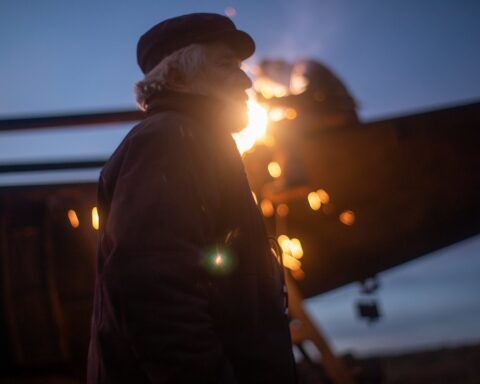Several of the conversations I’ve had about the current state of documentary in Canada at this year’s Hot Docs have turned on issues relating to both the cultural politics and the political economy of filmmaking. Understanding the larger social, cultural, political and economic contexts that anchor and impact our directors as they make their work helps us to understand the contemporary documentary scene with all its bumps and bruises. It’s safe to say that improvements need to be made in Canada’s community of makers, programmers, commissioning editors, producers, and everyone in between.
This background conversation was brought to the fore at Monday’s Doc Summit talk, where imagineNATIVE Artistic Director Jason Ryle asked tough questions about the Indigenous stories and the storytellers that are supported by the CBC. Fellow panelist filmmakers Lisa Jackson and Tasha Hubbard [Birth of a Family also didn’t mince words, in terms of representation and ethics, with Jackson talking about “inside jobs” and “outside jobs” and Hubbard reminding filmmakers to always ask themselves: “Am I the person to tell this story?” They also spoke of the need to build relationships over time with subjects and their communities. Both of these talented Indigenous directors believe that relationships should start before production and extend long after exhibition.
Following their crucial interjections into an industry often on speed-dial (from production to programming), I’d like to highlight four politically engaged Canadian documentaries that took the slow path. They all share a careful crafting of story, a contemplative and introspective nature, a willingness to spend time with their subjects and a deep commitment to relational ethics. The commitment in these films is to their subjects, and in some cases attendant politics, which shines bright in these exceptional works. Props to Hot Docs for a strong Canadian programme and to these committed filmmakers for bringing these exceptional stories to light after years of work.
State of Exception
Jason O’Hara started documenting land grabs and the expulsion of the poor in Rio seven years ago. His film weaves together a complex tapestry of struggles around the socio-economic cleansing of working poor and Indigenous neighbourhoods and communities in the lead up to the 2014 FIFA World Cup and the 2016 Olympic Games, both of which were held in Rio. Exposing the rapacious practices and brutal business of these emotionally and fiscally costly events and their impact on vulnerable communities who have built those same communities, O’Hara’s film unfurls as a complex web of culture and politics, money, power and resistance.
It is an inspired work that charts almost a decade of community organising and resistance to some of the most powerful neocolonial forces on the globe. The director’s dedication to the story and communities shows in every frame of the film. State of Exception is a moving documentary about threatened Indigenous communities, big business, and gentrification. The resilience of the filmmaker and subjects in this epic tale resonate as a testament to their long-term commitment to social justice.
It is a film that compellingly depicts marginalised communities who empower themselves and refuse to give up on their own story as Brazil’s unstoppable Indigenous and impoverished citizens. Also defiant is the editing in this ambitious film: O’Hara and collaborators shot hundreds of hours of direct action, political organising, state-directed bulldozing and razing, official government propaganda and more. The result is a riveting, multi-layered doc that oscillates between zooming into political actions and zooming out (often literally, with aerial shots) to communities in crisis. In its service to fair representation and the long struggle of its subjects, O’Hara’s film is an example of an outsider building long-term relationships with documentary subjects that will outlive picture lock. [ Read more about Jason O’Hara’s documentary in ‘Diary of a Guerrila Filmmaker’. ]
Manic
Placing a camera in front of one’s family is a daunting task at the best of times. When that family struggles with mental health issues, the stakes are compounded for those on both sides of the lens. Kalina Bertin’s intimate, stirring and life-changing Manic is a film that defies all expectations in its sensitive and emotionally intelligent exploration of a family dealing with instability and breakdowns. As stated in an introductory title card, Bertin’s debut feature seeks to reconcile two worlds: hers and that of her enigmatic father. Manic combines archival footage of childhood moments caught on home movie and other rare sources along with disquieting and disorienting scenes of contemporary family life into one of the most powerful films I have ever seen at Hot Docs.
Manic depicts Bertin’s journey to understand her contemporary family dynamics through the story of her father’s past as a charismatic person, and at times, cult leader. Sensitive camera work, incisive editing that moves between different settings, media sources and tonality seamlessly, a supporting score that is reminiscent of films by Lynch and Herzog, and an ethical use of access make this a must-see.
Bertin has created a film that simultaneously educates on mental health conditions and engages in loving, healthy ways to support those who suffer from such conditions. The commitment here is to the filmmaker’s own family, and her investigation into her father’s mysterious past, with all its upending discoveries, reminds us that there is no future without our pasts (to paraphrase Francine, the subject of Unarmed Verses, discussed below).
Manic is a film that has changed the way I think about family and about mental illness. It is an otherworldly film, one that has to be experienced to be felt, and that feeling is one of deep commitment, love and compassion. [ Read more about Kalina Bertin’s Manic in ‘The Freshmen’. ]
The Road Forward
Imagine if Canadians knew their own history. Imagine if Canadians knew Indigenous history. Imagine if that history focused on incredibly courageous and inspired activism that helped shape the country. Now imagine if this history was told as a musical. Lucky for us, we don’t need to imagine these things, because Métis director Marie Clements has the rich, boundless imagination that has brought the past to life on the big screen. The result is The Road Forward, a years-in-the-making project with numerous iterations, including music, theatre and now cinema.
Clements’ ambitious docu-musical gives fantastical vitality to the history of Indigenous activists in Western Canada over six generations, beginning with the founding of Canada’s first Indigenous newspaper, The Native Voice, to the Constitutional Express of the 80s through to Idle No More and activism around murdered and missing Indigenous women of recent times. That these compelling, country-shaping histories aren’t taught in most Canadian schools isn’t surprising. That they have been injected with the power of passionate song and performance is, surprisingly, amazing.
The Road Forward digs deep into Indigenous history while combining contemporary interviews with musical sequences and dramatisations in an audacious hybrid form. Some sequences are stronger than others, which is perhaps more of a testament to the astounding diversity of expression and collaboration bundled into Clements’ production than a formal shortcoming. When they do work, they pop.
The ensemble cast of Indigenous artists featured in this unique powder keg of creative activity interprets these histories through song and performance, while sharing in more quiet moments their own perspectives on Indigeneity and the colonial Canadian context. Clements’ bold treatment of this underserved past is told with political force and pronounced theatricality that recalls Aboriginal Australian artist Tracey Moffat’s genre-defying work like Night Cries and Bedevil, as well as Egyptian-Canadian Tahani Rached’s brilliant Au Chic Resto Pop. [ Read more about The Road Forward in ‘DOXA Pushes the Boundaries’. ]
Unarmed Verses
Charles Officer developed relationships with the community of Villaways in North York years before shooting this beautiful, moving and reflexive film. Unarmed Verses is a study of place, a portrait of community and a celebration of humanity. Faced with forced relocation, the residents of Villaways, who are not accidentally mostly people of colour, continue to live their closely connected lives in the years leading up to the razing of their neighbourhood. The resulting film is a resplendent, disquieting work of passion and purpose.
Marginalisation manifests in various forms—material, social, economic, political—yet one of the most hidden and accepted kinds is cultural. Black Canadians and people of colour are too often pushed to the edges of dominant visual culture frames, maligned as racist stereotypes, or ignored altogether. Officer’s film is a powerful corrective to this unjust reality.
A quietly poetic mise-en-scene mixes with dynamic and inspiring subjects in this exceptional work. Officer follows Francine and other youth in the community at home, at school, and at after-hour learning centres, where they are taught to express themselves through music. Unarmed Verses is a cultural intervention that will undoubtedly be added to the documentary canon in this country. There is much love, determination and relationship building in front of and behind the camera in Officer’s frames and it is infectious, maybe even transformative. [ Read more about Unarmed Verses in ‘Neighbourhood Watch’. ]
Committed Documentaries
The exceptional stories captured over long processes of filmmaking and relationship building in these four docs employ a process not available, nor considered by, all filmmakers. It is no surprise that two — The Road Forward and Unarmed Verses —-are NFB productions. A state-funded media organisation, the Board is better positioned than commercial producers to let artists make films as slowly, and thoughtfully, as they need to achieve their results.
Countering our rush to produce, present and consume stories instantaneously, these four Canadian gems show that slowing down and sticking with your subjects in allied strength and commitment makes us all stronger in the end.









